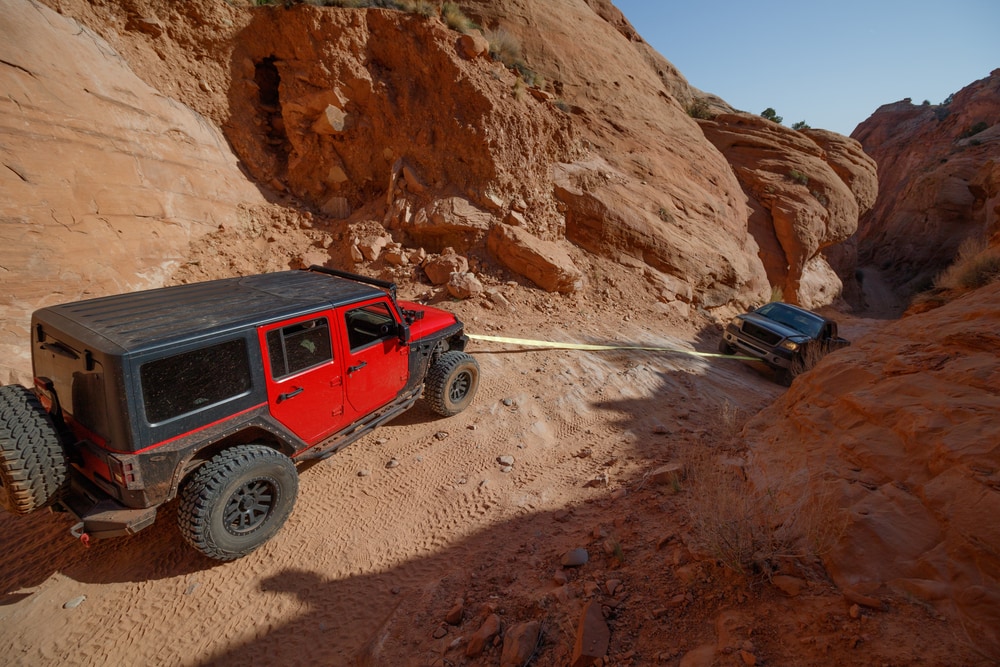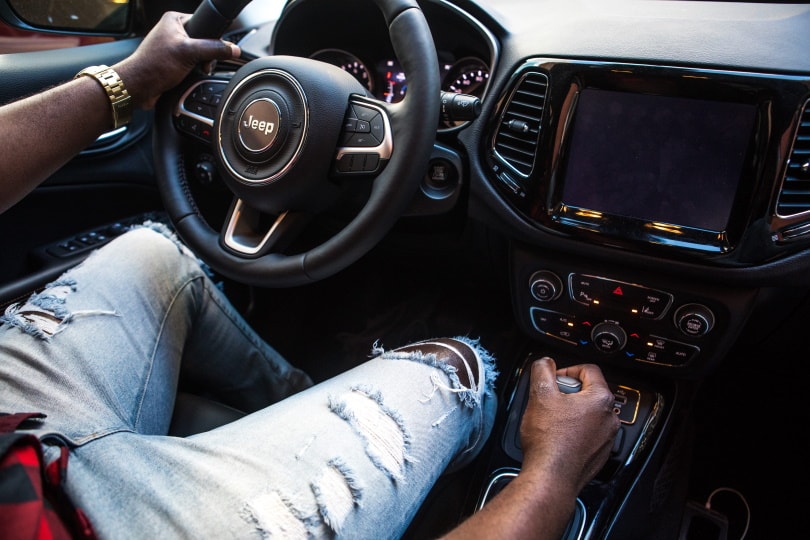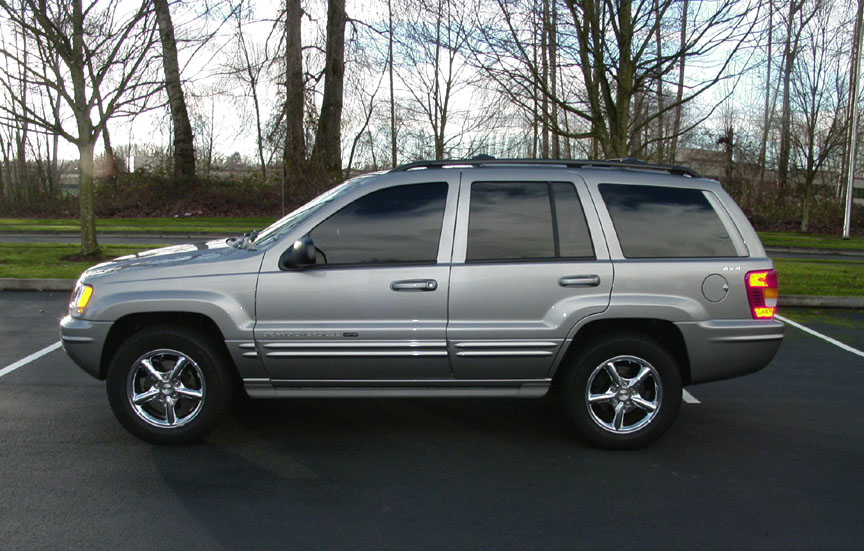- Jeep Grand Cherokee Towing Capacity: Pros, Cons, Models, & FAQ
- General Overview of Jeep Grand Cherokee
- Jeep Grand Cherokee Towing Capacities Through the Years
- Why Does Towing Capacity Not Change Much?
- Advantages of Grand Cherokee
- Disadvantages of Grand Cherokee
- FAQs
- Can a Jeep Grand Cherokee pull a trailer?
- What does a “tow package” include?
- Does the Grand Cherokee offer the best towing of all Jeep models?
- Conclusion
- Jeep WJ Grand Cherokee Towing Guide
- STANDARD PROCEDURE – TOWING RECOMMENDATIONS
- TWO-WHEEL-DRIVE VEHICLE TOWING
- FOUR-WHEEL-DRIVE VEHICLE TOWING
- RECREATIONAL TOWING
- A. Shifting Into Neutral (N)
Jeep Grand Cherokee Towing Capacity: Pros, Cons, Models, & FAQ
For the last 30 years, Jeep has been making the Grand Cherokee, and it’s one of Jeep’s fan favorites. Not only does it boast impressive towing capabilities, but it’s also rugged and capable of going almost anywhere you want it to go with the right package options. It depends on the model of Jeep Grand Cherokee, but you can expect to tow between 6,200-7,400 lbs.
Let’s take a look at the Grand Cherokee’s towing capacities throughout the years and some of the features that make it stand out in a crowd.
General Overview of Jeep Grand Cherokee
The Grand Cherokee has two drivetrain options; rear-wheel drive, and four-wheel drive. It’s also currently available with a V6, V8, or plug-in hybrid engine. And if you want to pick and choose which options you get, there are eight trim levels to choose from. The popular off-road picks are the Trailhawk and SRT.
If it’s in the budget, the Grand Cherokee is a great mid-size SUV if you’re looking for something you can get dirty with, haul your toys, or make a trip to the grocery store. Plus, the SUV seats five, so you can bring the whole family. But if you’re looking to fill all seats, the cabin’s lack of additional cargo space will not impress you.
Overall, the Jeep Grand Cherokee does a great job balancing a vehicle that can work its tail off but still makes a great daily driver filled with the features that many people want nowadays, like leather, heated seats, and technology connections.
Jeep Grand Cherokee Towing Capacities Through the Years
Jeep’s Grand Cherokee models have remained largely unchanged from year to year and trim to trim for the last several years. The minor changes made did not impact towing capability. Nearly 10 years ago, in the 2014–2016 model years, they offered an extra heavy-duty package with a slightly increased tow package.
| Jeep Grand Cherokee Year | Max Towing Capacity |
| 2021 | 6,200 / 7,200 lbs |
| 2020 | 6,200 / 7,200 lbs |
| 2019 | 6,200 / 7,200 lbs |
| 2018 | 6,200 / 7,200 lbs |
| 2017 | 6,200 / 7,200 lbs |
| 2016 | 6,200 / 7,200 / 7,400 lbs |
| 2015 | 6,200 / 7,200 / 7,400 lbs |
| 2014 | 6,200 / 7,200 / 7,400 lbs |
Why Does Towing Capacity Not Change Much?
All Grand Cherokee models back to 2011 are part of the model’s fourth generation. As a result, there have been no significant chassis and frame changes. Although, they have certainly undergone various cosmetic changes and some significantly different engine technologies throughout the years.
But none of these changes have offered any significant difference in towing other than for the brief 2014–2016 model years when Jeep offered the extra heavy-duty class four V8 engine and towing package. This tow package gave a slight boost to towing. This didn’t last long because the extra 200 lbs weren’t enough of a draw for people.
Things like suspension, brakes, engine, and transmission all play a huge role in how much a vehicle can tow. But a chassis determines how weight is distributed, which changes how much these things affect the calculations. Because very little was done to the chassis over the years is a major reason why towing capacity has not changed for the Grand Cherokee.
Advantages of Grand Cherokee
There is a huge range of package options for the Grand Cherokee. Suppose the towing ability is a secondary concern. In that case, you can opt for a less expensive trim level and still get 3,000–5,000 lbs of towing power. Another great thing about the Grand Cherokee is how popular they are. So, if you’re into modifying your vehicles, you’ll find no shortage of aftermarket upgrades you can do to the performance and looks of your SUV.
Disadvantages of Grand Cherokee
The Jeep Grand Cherokee is not the most affordable option if you’re a budget-conscious shopper. If you’re looking for the most power, towing, and features, you’ll be spending upwards of $50,000 or more. So, if you simply want pulling power, there are more affordable options on the market that offer the same or better towing.
However, if you want a Jeep, the Grand Cherokee offers the second-best towing in the entire Jeep lineup. The Gladiator is the only one that has a slightly higher towing capacity, but then you’re losing a lot of interior space.
FAQs
Can a Jeep Grand Cherokee pull a trailer?
As long as you have the SRT or Trackhawk, you can pull up to 7,200 lbs. Keep in mind that this weight rating includes the weight of the trailer and anything you’re putting in it. When combined, the weight cannot exceed the manufacturer’s weight rating. This includes campers, boats, or anything else you’ll tow with your Grand Cherokee.
What does a “tow package” include?
When you purchase a Jeep with a tow package, it will include a few extra things. For starters, it will be wired for trailer lights and include a four and seven-pin harness. In addition, you’ll get a class four hitch receiver, load-leveling suspension in the rear, and increased transmission and engine cooling options. Plus, you’ll have a full-size spare tire for those long treks in the wilderness.
Does the Grand Cherokee offer the best towing of all Jeep models?
The Grand Cherokee offers the second-best towing. The only Jeep that has more is the Gladiator, which offers 7,650 lbs. However, the Jeep Gladiator is a pickup truck that offers less internal storage and seating. So, if you’re looking for an SUV with the power for towing, the Grand Cherokee is the best Jeep option.
Conclusion
The Jeep Grand Cherokee has been one of Jeep’s most popular models for many years, and for a good reason. They look great, have some awesome options, and they can tow pretty much whatever the average person can throw at it. Whether you’re working or playing with it, there is likely a trim level that will do the trick for you.
You Might Also Be Interested In:
Featured Image Credit: Jeppe Karl, Shutterstock
Jeep WJ Grand Cherokee Towing Guide
Welcome to the JeepSpecs.com in-depth page on WJ Generation Jeep Grand Cherokee towing guide. We have organized as much information as we could find into a helpful article below. Is something incorrect or missing? Please get in touch with us and we’ll fix it!
STANDARD PROCEDURE – TOWING RECOMMENDATIONS
A vehicle equipped with SAE approved wheel lift type towing equipment can be used to tow WJ vehicles. When towing a 4WD vehicle using a wheel-lift towing device, use tow dollies under the opposite end of the vehicle. A vehicle with flatbed device can also be used to transport a disabled vehicle.
CAUTION: The following safety precautions must be observed when towing a vehicle:
- Do not use steering column lock to secure steering wheel during towing operation. 2WD vehicles can be towed with the front wheels on the surface for extended distances at speeds not exceeding 48 km/h (30 mph).
- Many vehicles are equipped with air dams, spoilers, and/or ground effect panels. To avoid component damage, a wheel-lift towing vehicle or a flat-bed hauling vehicle is recommended.
- Secure loose and protruding parts.
- Always use a safety chain system that is independent of the lifting and towing equipment.
- Do not allow towing equipment to contact the disabled vehicle’s fuel tank.
- Do not allow anyone under the disabled vehicle while it is lifted by the towing device.
- Do not allow passengers to ride in a vehicle being towed.
- Always observe state and local laws regarding towing regulations.
- Do not tow a vehicle in a manner that could jeopardize the safety of the operator, pedestrians or other motorists.
- Do not attach tow chains, T-hooks, or J-hooks to a bumper, steering linkage, drive shafts or a non-reinforced frame hole.
- Do not tow a heavily loaded vehicle. Use a flatbed device to transport a loaded vehicle.
WARNING: When towing a disabled WJ vehicle and the drive wheels are secured in a wheel lift or tow dollies, ensure the transmission is in the Park position.
WARNING: Ensure vehicle is on a level surface or the wheels are blocked to prevent vehicle from rolling.
TWO-WHEEL-DRIVE VEHICLE TOWING
DaimlerChrysler Corporation recommends that a vehicle be towed with the rear end lifted, whenever possible.
Two wheel drive towing – rear end lifted
1. Attach wheel lift device to front wheels.
2. Place the transmission in neutral.
3. Raise vehicle to towing position.
4. Attach safety chains. Route chains so not to interfere with tail pipe when vehicle is lifted.
5. Turn the ignition switch to the OFF position to unlock the steering wheel.
6. Secure steering wheel in straight ahead position with a clamp device designed for towing.
7. Place transmission in park.
Two wheel drive towing – front end lifted
1. Attach wheel lift device to rear wheels.
2. Place the transmission in neutral.
3. Raise the rear of the vehicle off the ground and install tow dollies under rear wheels.
4. Attach wheel lift device to front wheels and raise vehicle to towing position.
5. Attach the safety chains. 6. Turn the ignition switch to the OFF position to unlock the steering wheel.
7. Secure steering wheel in straight ahead position with a clamp device designed for towing
8. Place transmission in park.
FOUR-WHEEL-DRIVE VEHICLE TOWING
DaimlerChrysler Corporation recommends that a 4WD vehicle be transported on a flat-bed device. A Wheel-lift device can be used provided the trailing wheels are off the ground and positioned in tow dollies.
Four wheel drive towing – rear end lifted
1. Attach wheel lift device to front wheels.
2. Place the transmission in neutral.
3. Raise the front of the vehicle off the ground and install tow dollies under front wheels.
4. Attach wheel lift device to rear wheels and raise vehicle to towing position.
5. Attach safety chains. Route chains so not to interfere with tail pipe when vehicle is lifted.
6. Turn the ignition switch to the OFF position to unlock the steering wheel.
7. Secure steering wheel in straight ahead position with a clamp device designed for towing.
8. Place transmission in park.
Four wheel drive towing – front end lifted
1. Attach wheel lift device to rear wheels.
2. Place the transmission in neutral.
3. Raise the rear of the vehicle off the ground and install tow dollies under rear wheels.
4. Attach wheel lift device to front wheels and raise vehicle to towing position.
5. Attach the safety chains.
6. Turn the ignition switch to the OFF position to unlock the steering wheel.
7. Secure steering wheel in straight ahead position with a clamp device designed for towing
8. Place transmission in park.
RECREATIONAL TOWING
CAUTION! Internal damage to the transfer case will occur if a front or rear wheel lift is used then recreational towing.
NOTE: The transfer case must be shifted into N (Neutral) for recreational towing.
A. Shifting Into Neutral (N)
Use the following procedure to prepare your vehicle for recreational towing.
CAUTION! It is necessary to follow these steps to be certain that the transfer case is fully in N (Neutral) before recreational towing to prevent damage to internal parts.
1. Depress brake pedal.
2. Shift transmission into N (Neutral).
3. Shift transfer case lever into N (Neutral).
4. Start engine.
5. Shift transmission into D (Drive)
6. Release brake pedal and ensure that there is no vehicle movement.
7. Shut the engine OFF and place the ignition key into the unlocked OFF position.
8. Shift transmission into P (Park).
9. Apply parking brake.
10. Attach vehicle to the tow vehicle with tow bar.
11. Release parking brake.
CAUTION! Transmission damage may occur if the transmission is shifted into P (Park) with the transfer case in N (Neutral) and the engine running. With the transfer case in N (Neutral) ensure that the engine is OFF prior to shifting the transmission into P (Park) (refer to steps 7 – 8 above).
B. Shifting Out Of Neutral (N)
Use the following procedure to prepare your vehicle for normal usage.
1. Shift transmission into N (Neutral).
2. Shift transfer case lever to desired position.
3. Shift transmission into D (Drive).
NOTE: When shifting out of transfer case N (neutral), turning the engine OFF may be required to avoid gear clash.
WARNING! You or others could be injured if your leave the vehicle unattended with the transfer case in the N (Neutral) position without first fully engaging the parking brake. The transfer case N (Neutral) position disengages both the front and rear driveshafts from the powertrain and will allow the vehicle to move regardless of the transmission position. The parking brake should always be applied when the driver is not in the vehicle.
CAUTION! Do not use a bumper mounted clamp-on tow bar on your vehicle. The bumper face bar will be damaged. Do not disconnect the rear driveshaft because fluid will leak from the transfer case and damage internal parts.






